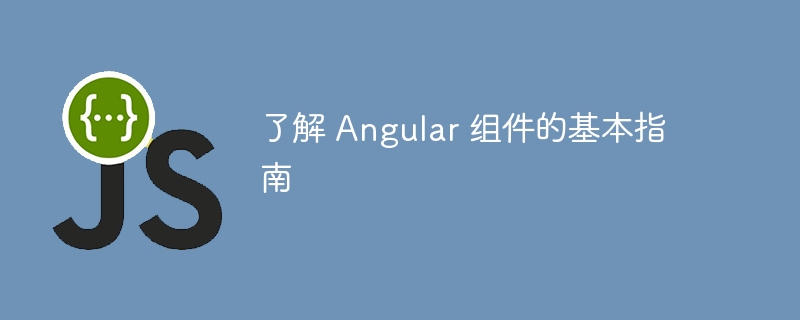
angular 组件是 angular 应用程序的基础,提供了一种构建用户界面的模块化、可重用部分的方法。在本指南中,我们将介绍 angular 组件的基础知识,从结构到最佳实践。无论您是 angular 新手还是想复习一下,本文都将使您对 angular 中的组件有一个基本的了解。
在 angular 中,组件是控制用户界面 (ui) 部分的类。想想按钮、选项卡、输入、表单和抽屉(实际上是 ui 的任何部分)。每个组件都是独立的,包括:
组件对于创建模块化应用程序至关重要,因为每个组件都可以代表页面的特定部分,例如标题、侧边栏或卡片。
angular 组件是使用 @component 装饰器定义的,它使用必要的模板、样式和选择器对其进行配置。这是一个基本示例:
import { component } from '@angular/core';
@component({
selector: 'app-example',
templateurl: './example.component.html',
styleurls: ['./example.component.css']
})
export class examplecomponent {
title: string = 'hello, angular!';
gettitle() {
return this.title;
}
}
在此示例中:
angular 项目通常将组件及其关联文件组织在一个文件夹中,该文件夹是使用 angular cli 时自动创建的。组件的典型文件夹结构包括:
angular 组件具有带有钩子的生命周期,允许开发人员在各个阶段执行操作。常用的生命周期钩子包括:
例如,ngoninit 的使用方法如下:
import { component, oninit } from '@angular/core';
@component({
selector: 'app-lifecycle',
template: '<p>lifecycle example</p>',
})
export class lifecyclecomponent implements oninit {
ngoninit() {
console.log('component initialized!');
}
}
生命周期挂钩提供了灵活性,可以轻松管理组件生命周期特定阶段的逻辑。
在现实应用程序中,组件通常需要相互交互以共享数据或触发操作。 angular 提供了几种组件通信的方法:
示例:
// child.component.ts
import { component, input, output, eventemitter } from '@angular/core';
@component({
selector: 'app-child',
template: `<button (click)="sendmessage()">send message</button>`,
})
export class childcomponent {
@input() childmessage: string;
@output() messageevent = new eventemitter<string>();
sendmessage() {
this.messageevent.emit('message from child!');
}
}
<!-- parent.component.html --> <app-child [childmessage]="parentmessage" (messageevent)="receivemessage($event)"></app-child>
当组件不存在父子关系时,angular 服务提供了一种共享数据和逻辑的简单方法。默认情况下,服务是单例的,这意味着应用程序中仅存在一个实例。
import { injectable } from '@angular/core';
import { behaviorsubject } from 'rxjs';
@injectable({
providedin: 'root'
})
export class sharedservice {
private messagesource = new behaviorsubject<string>('default message');
currentmessage = this.messagesource.asobservable();
changemessage(message: string) {
this.messagesource.next(message);
}
}
在不同组件中使用服务:
// component-one.ts
import { component } from '@angular/core';
import { sharedservice } from '../shared.service';
@component({
selector: 'app-component-one',
template: `<button (click)="changemessage()">change message</button>`,
})
export class componentone {
constructor(private sharedservice: sharedservice) {}
changemessage() {
this.sharedservice.changemessage('hello from component one');
}
}
// component-two.ts
import { Component, OnInit } from '@angular/core';
import { SharedService } from '../shared.service';
@Component({
selector: 'app-component-two',
template: `<p>{{ message }}</p>`,
})
export class ComponentTwo implements OnInit {
message: string;
constructor(private sharedService: SharedService) {}
ngOnInit() {
this.sharedService.currentMessage.subscribe(message => this.message = message);
}
}
angular 组件是构建可扩展和模块化应用程序的核心。通过了解它们的结构、生命周期和通信方法,您可以创建高效、可维护且易于理解和构建的应用程序。
在下一篇文章中,我们将更详细地探讨 angular 组件生命周期,探索每个钩子以及如何使用它来有效管理组件。请继续关注,深入了解 angular 强大的生命周期功能!
以上就是了解 Angular 组件的基本指南的详细内容,更多请关注php中文网其它相关文章!

每个人都需要一台速度更快、更稳定的 PC。随着时间的推移,垃圾文件、旧注册表数据和不必要的后台进程会占用资源并降低性能。幸运的是,许多工具可以让 Windows 保持平稳运行。

Copyright 2014-2025 https://www.php.cn/ All Rights Reserved | php.cn | 湘ICP备2023035733号